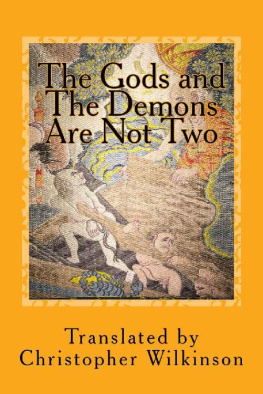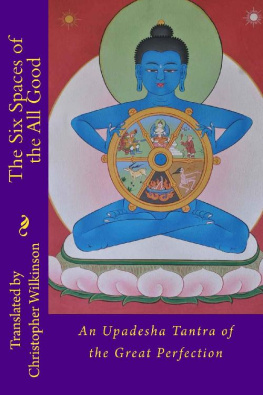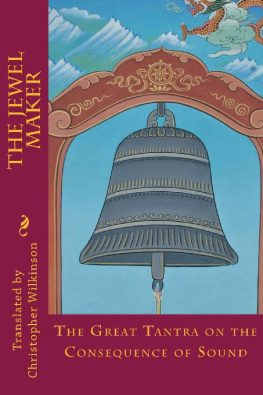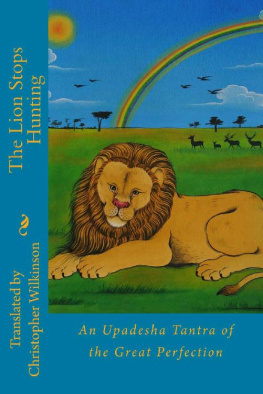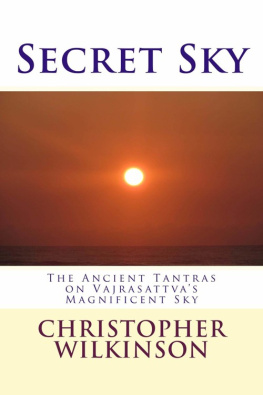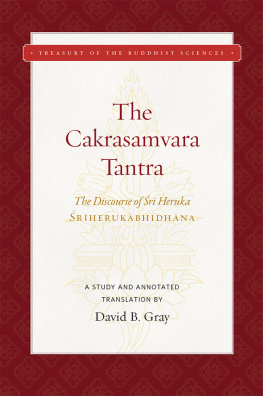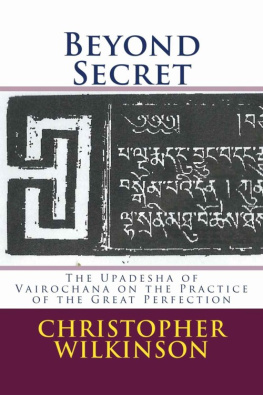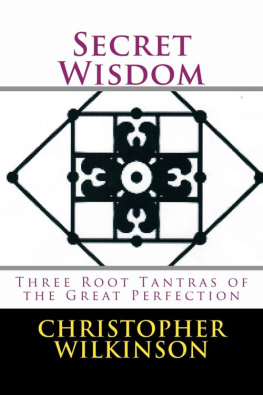The Secret Tantras of The Fish Wheel and The Nine Spaces With Tibetan Text Translated By Christopher Wilkinson The painting of the fish on the cover was done by Tsering Kelsang, a master painter who is currently residing in Sikkim. 2016 Tsering Kelsang. No part of this book may be reproduced in any form or by any electronic or mechanical means including information storage and retrieval systems, without permission in writing from the author. The only exception is by a reviewer, who may quote excerpts in a review. Published by Christopher Wilkinson Cambridge, MA, USA Copyright 2016 Christopher Wilkinson All rights reserved. ISBN : 1533192057 ISBN-13 : 978-1533192059 DEDICATION This is for all the teachers and students of the Great Perfection.
Also translated by Christopher Wilkinson Great Perfection Series: Ten Early Tantras of the Great Perfection: A Basket of Diamonds The Gods and the Demons Are Not Two: A Tantra of the Great Perfection The Tantra of Great Bliss: The Guhyagarbha Transmission of Vajrasattvas Magnificent Sky Secret Sky: The Ancient Tantras on Vajrasattvas Magnificent Sky The Great Tantra of Vajrasattva: Equal to the End of the Sky Beyond Secret: The Upadesha of Vairochana on the Practice of the Great Perfection Secret Wisdom: Three Root Tantras of the Great Perfection Sakya Kongma Series: Sakya Panditas Poetic Wisdom Jetsun Dragpa Gyaltsan: The Hermit King Admission at Dharmas Gate by Sonam Tsemo An Overview of Tantra and Related Works Chogyal Phagpa: The Emperors Guru Advice to Kublai Khan: Letters by the Tibetan Monk Chogyal Phagpa To Kublai Khan and his Court At The Court of Kublai Khan: Writings of the Tibetan Monk Chogyal Phagpa CONTENTS
| Acknowledgments | i |
| Introduction | iii |
| The Bodhicitta Fish Wheel Tantra | |
| Teaching the Basic Scene | |
| Teaching that the Mind and Its Object Are One | |
| Teaching the Practice of Great Bliss | |
| Teaching the True Nature of the Mind | |
| Teaching that Awareness is Beyond Our Fields of Practice | |
| The Wheel of Wisdom is not Named | |
| The Secret Door of Royal Investiture | |
| Spontaneous Perfection without Practice | |
| There is No Travel or Study | |
| A Commentary on Wisdom | |
| Teaching Wisdom | |
| A Teaching That Is Inclusive of All Things | |
| Teaching That the Perfection in the Awareness of a Spontaneous Realization is Beyond Protection | |
| Teachings on What Is beyond Deeds and Searches | |
| Spontaneous Realization | |
| Taking Hold of the Tantra | |
| The Tantra on the Nine Spaces Of the Ocean of the Bodhicitta | |
| The Secret of the Basic Scene | |
| Natural Space | |
| The Space of the View | |
| The Space of the Great Mandala | |
| Unobstructed Wisdom | |
| The Space of Secret Practice | |
| The Space of Secret Contemplation | |
| The Brahmanic Empowerment of the Investiture of Royalty | |
| The Space of the Levels and the Paths That Are Not to Be Travelled Over | |
| The Space of the Samaya That Are Not to Be Protected | |
| The Space of the Spontaneously Realized Precious Result | |
| The Bequest and the Reception of the Tantra | |
| The Tibetan Texts | |
| The Bodhicitta Fish Wheel Tantra | |
| The Tantra on the Nine Spaces of the Ocean of the Bodhicitta | |
| About the Translator | |
ACKNOWLEDGMENTS First and foremost, I wish to thank my root teacher Dezhung Rinpoche for constantly bringing out the best in me and encouraging me to pursue a comprehension of every branch of Buddhist learning. It was he who introduced me to Dilgo Kyentse Rinpoche, and through his recommendations enabled me to receive full empowerments, transmissions, and permissions in the areas of Mah, Anu, and Ati Yogas. With the highest regard I wish to thank Dilgo Kyentse Rinpoche, Khetsun Zangpo Rinpoche, Nyoshul Khen Rinpoche, and Khenpo Palden Sherab for their kind instruction and encouragement in my effort to translate the literature of the rDzogs chen. There are many individuals, too many to name here, that have helped me over the years to become a qualified translator, in many ways. At this time I want to remember the kindness of Ngawang Kunga Trinlay Sakyapa, Jigdral Dagchen Sakya Rinpoche, Dhongthog Rinpoche, H.H. Karmapa Rangjung Rigpay Dorje, Kalu Rinpoche, Chogyam Trungpa Rinpoche, Geshe Ngawang Nornang, Carl Potter, David Ruegg, Turrell Wylie, Gene Smith, Karen Lang, Richard Solomon, Jack Hawley, David Jackson, Cyrus Stearns, Herbert Guenther, Eva Neumeier-Dargyay, Leslie Kawamura, Robert Thurman, Paul Nietupski, Lou Lancaster, David Snellgrove, Jean-Luc Achard, Steve Landsberg, Tsultrim Alione, Carolyn Klein, Rob Mayer, Jonathan Silk, David White, Mark Tatz, Steve Goodman, and Kennard Lipman.
I want to make special thanks to Marcos Gonzalez Pardo for proofing the manuscript and to Robert J. Barnhart for his generous support. I also want to offer a very special thank you to Tsering Kelsang, who painted the wonderful image of a fish for the cover of this book, most excellently and on short notice. The many people who have contributed to my understanding and ability to do this work cannot be counted. I wish to thank everyone that has taken a kind interest in these translations, however slight, for your part in making this work a reality. Introduction The Great Perfection, also known as the Atiyoga or Dzogchen ( rDzogs chen ), is a tradition of esoteric Buddhism that was first transmitted from India to Tibet in the Eighth Century of the Common Era.
The Tantras translated in this volume were among the earliest translations into Tibetan, and are preserved in the manuscript collections known as the Hundred Thousand Tantras of the Ancients ( rNying ma rgyud bum ) and the Hundred Thousand Tantras of Vairochana ( Vairoi rgyud bum ). The Tantra of the Nine Spaces clearly states that it was translated by Vairochana, a Tibetan monk who had gone to India in the Eighth Century in search of the teachings on instantaneous enlightenment, and r Singha, indicating that the translation was done while Vairochana was still in India with his guru. The Fish Wheel Tantra does not indicate who its translators were, but its inclusion in the Hundred Thousand Tantras of Vairochana is evidence that the Tibetan tradition held it to be the work of Vairochana. I have included the Tibetan texts of these works for your convenience and to help preserve this ancient literature. Many of the Tantras of the Great Perfection clearly state that they are intended for everyone to read, while some of them are declared to be very secret. The two Tantras translated in this volume are secret, and are not intended to be widely broadcast.
The Fish Wheel Tantra states: These are the oral transmissions from the remote caverns, the quintessence of quintessences of the teachings. If they are scattered about, the dakini r Jamunta will truly tear out our hearts. The Tantra of the Nine Spaces states: Do not teach this to any three people. It is bequeathed to a single sure regent. We may be sure that these Tantras contain content that is most secret. These Tantras are not, however, like some of the secret Tantras found in the Buddhist and Hindu traditions that describe hidden sexual practices or feature elaborately coded mantras.
On reading them, in fact, we might wonder why they are considered secret, as they do not advocate any transgressive practices of any kind. It is worth remembering that in the world these books were written the only way to get a book was to copy it from someone who had it. A guru who was in possession of books would evaluate someone very carefully before allowing them the opportunity to copy them or to have them copied. If the content of a book was such that problems might arise if it were misunderstood, the chances for a student to get it and copy it would be dramatically reduced. Such is the case with the books in this volume. The contents are such that they might easily be misunderstood, resulting in problems for the ones who had copies of them, and the loss of the books themselves.
Next page

